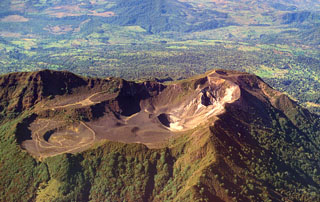Report on Turrialba (Costa Rica) — 29 May-4 June 2013
Smithsonian Institution / US Geological Survey
Weekly Volcanic Activity Report, 29 May-4 June 2013
Managing Editor: Sally Sennert.
Please cite this report as:
Global Volcanism Program, 2013. Report on Turrialba (Costa Rica) (Sennert, S, ed.). Weekly Volcanic Activity Report, 29 May-4 June 2013. Smithsonian Institution and US Geological Survey.
Turrialba
Costa Rica
10.025°N, 83.767°W; summit elev. 3340 m
All times are local (unless otherwise noted)
OVSICORI-UNA reported that on 29 May a pilot flying past Turrialba about 40 km away observed a blackish plume. Officials from the Parque Nacional Volcán Turrialba observed a gas plume that was slightly darker than usual between 0730 and 0745; seismic records showed no abnormal activity at those times or during the previous 48 hours. In addition, web camera images showed no noticeable ash emissions since 23 May. Gas plumes over 750 degrees Celsius were emitted from Boca 2010 (on the W wall) and Boca 2012 (on the E wall). The plume from Boca 2010 was whiter than the plume emitted from Boca 2012, mainly due to the difference in the ratio of magmatic gases and aerosols, and no ash.
On 4 June slight ashfall was reported in Pacayas and San Pablo in Oreamuno de Cartago (25 km SW). An observer in the National Park noted that between 1400 and 1500 gas emissions were slightly stronger and also grayish.
Geological Summary. Turrialba, the easternmost of Costa Rica's Holocene volcanoes, is a large vegetated basaltic-to-dacitic stratovolcano located across a broad saddle NE of Irazú volcano overlooking the city of Cartago. The massive edifice covers an area of 500 km2. Three well-defined craters occur at the upper SW end of a broad 800 x 2200 m summit depression that is breached to the NE. Most activity originated from the summit vent complex, but two pyroclastic cones are located on the SW flank. Five major explosive eruptions have occurred during the past 3500 years. A series of explosive eruptions during the 19th century were sometimes accompanied by pyroclastic flows. Fumarolic activity continues at the central and SW summit craters.
Source: Observatorio Vulcanologico y Sismologico de Costa Rica-Universidad Nacional (OVSICORI-UNA)

